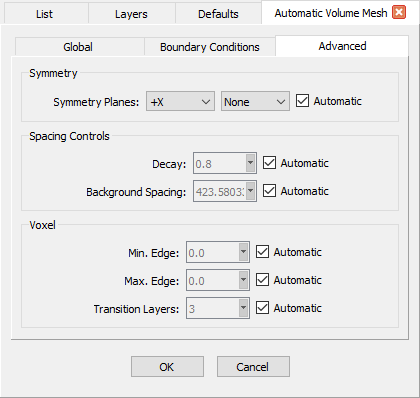Description
The Advanced panel provides additional tools to define symmetry planes, adjust spacing controls, and control the behavior of voxel cells.

Symmetry
The Symmetry frame provides tools for setting up the symmetry plane definition for the new block and is only available when entering Automatic Volume Mesh in Create Boundaries mode. The Automatic checkbox specifies that Automatic Volume Mesh should automatically identify up to two symmetry planes and is checked on by default. For a symmetry plane to be automatically identified, the selected domains must contain a closed loop of lamina connectors that lie within tolerance of one of the principal planes. This symmetry tolerance is computed as the smaller of the Connector tolerance and a small fractional percent of the maximum extent of the block being defined. Uncheck the Automatic checkbox and use the dropdown lists to manually select up to two symmetry planes.Tip: A group of lamina connectors could fail to be identified by Automatic Volume Mesh as being on a symmetry plane (i.e. rendered in red) by one of two reasons: they don't form a closed loop or their grid points are not within tolerance of one of the principal planes. If the problem is the latter, you can create a database plane in the location of the desired symmetry plane and project the lamina connectors onto it. For more information, please refer to the sections on the Create, Planes and Edit, Project commands in this User Manual.
Spacing Controls
The Spacing Controls frame provides tools for specifying spacing controls on the interior of the volume and is only available when entering Automatic Volume Mesh in Create Boundaries mode.
The Decay parameter is used to specify a decay factor that propagates the spacing on the bounding domains further into the interior of the isotropic region of the block to be created. The Decay parameter varies from 0.0 to 1.0 and has a default value of 0.8. A value of 0.0 indicates no influence beyond the boundary and 1.0 indicates maximum influence. Uncheck the Automatic checkbox to edit the value.
The Background Spacing parameter is used to specify a constant target spacing throughout the interior of the isotropic portion of the block to be created. By default, the Automatic checkbox is checked on, indicating that the value be determined automatically from the Decay value described above and the extents of the block. Uncheck the Automatic checkbox to edit the value.
For more information about the settings in the Spacing Controls frame, please refer to the section on the Size Field in this User Manual.
Voxel
The Voxel frame provides tools for controlling the behavior of the voxel cells in the isotropic region of the volume and is only enabled if the Type parameter is set to Voxel on the Global tab.
Use the Min. Edge and Max. Edge parameters to specify a desired minimum and maximum edge length for voxel cells, respectively. By default, these values are determined automatically by Automatic Volume Mesh from the selected domains and/or extents of the block to be created. Uncheck the Automatic checkbox to edit the values.
Note: Voxel cells are created by iteratively subdividing larger cells to satisfy the Size Field. The Min. Edge parameter is used in two ways. First, an initial number of subdivisions is chosen for the extents of the block that best matches the value prescribed for Min. Edge. These initial voxel cells are then refined to satisfy the value prescribed for Max. Edge. Secondly, the Min. Edge parameter is used as the lower limit to stop the refinement process. The actual voxel edge lengths may vary below this value, but not by more than one refinement level. When not using automatically determined values, it is recommended to set both Min. Edge and Max. Edge to be related by powers of 2 in order to avoid confusion.
The Transition Layers parameter specifies the target number of layers of equally-sized hexahedral cells before transitioning to the next size of voxel cells. The default value for Transition Layers is 3. Uncheck the Automatic checkbox to edit the value. For more information about the settings in the Voxel frame, please refer to the Voxel section of this User Manual.